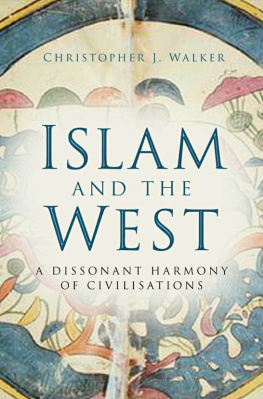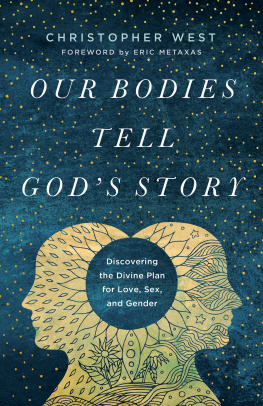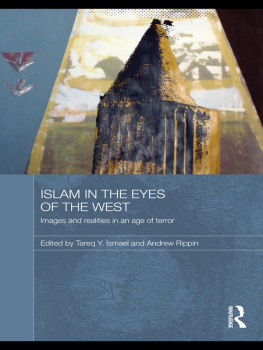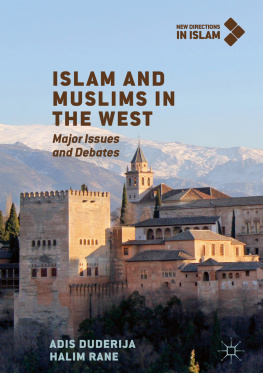Christopher J. Walker - Islam and the West
Here you can read online Christopher J. Walker - Islam and the West full text of the book (entire story) in english for free. Download pdf and epub, get meaning, cover and reviews about this ebook. year: 2013, publisher: The History Press, genre: Religion. Description of the work, (preface) as well as reviews are available. Best literature library LitArk.com created for fans of good reading and offers a wide selection of genres:
Romance novel
Science fiction
Adventure
Detective
Science
History
Home and family
Prose
Art
Politics
Computer
Non-fiction
Religion
Business
Children
Humor
Choose a favorite category and find really read worthwhile books. Enjoy immersion in the world of imagination, feel the emotions of the characters or learn something new for yourself, make an fascinating discovery.
- Book:Islam and the West
- Author:
- Publisher:The History Press
- Genre:
- Year:2013
- Rating:5 / 5
- Favourites:Add to favourites
- Your mark:
- 100
- 1
- 2
- 3
- 4
- 5
Islam and the West: summary, description and annotation
We offer to read an annotation, description, summary or preface (depends on what the author of the book "Islam and the West" wrote himself). If you haven't found the necessary information about the book — write in the comments, we will try to find it.
Islam and the West — read online for free the complete book (whole text) full work
Below is the text of the book, divided by pages. System saving the place of the last page read, allows you to conveniently read the book "Islam and the West" online for free, without having to search again every time where you left off. Put a bookmark, and you can go to the page where you finished reading at any time.
Font size:
Interval:
Bookmark:

H elena, the mother of the Emperor Constantine, first accorded Jerusalem a central place within Roman Christianity, by making a pilgrimage there probably in the year 326. According to the pious historians Socrates Scholasticus and Sozomen, she discovered the site of the Holy Sepulchre. At the time of her visit this sacred place was occupied by a temple built by the Emperor Hadrian and dedicated to Astarte. The devout lady pilgrim, granted the title of empress by her imperial son, dutifully sought out other sites connected with the life of Jesus, and discovered a holy relic of deep and lasting significance, that of the True Cross. Her devotional travels inaugurated the powerful and lasting tradition of Christian pilgrimage the process whereby inner spirituality is strengthened and enriched by an outward journey of aspiration, physical hardship, attainment, presence, recollection and meditation.
Astarte was the local cult-name for Venus, and even in pagan times an aura of sacred suffering and renewal hovered in the darkened grotto. The rites of Syrian Adonis, the annual life-replenishing corn-god, were celebrated here in springtime. A link has been suggested between Adonis and Adonai; the womb which nurtured the fresh-limbed god of springtime became the tomb of the Son of Man. Perhaps we can also find here a continuity of female presence, with Astarte foreshadowing Mary Magdalene and the other women at the empty tomb, who in turn could be linked to the historical figure of Helena. The ambience was in contrast to the robustly male environment of the other great sacred place, the former Jewish Temple, manifestly masculine in its pagan Roman form as the Temple of Jupiter Capitolinus.
Christianity had evolved from being a faith of the oppressed into a triumphant imperial religion. From being a subversive doctrine challenging the divinity of the emperor and waiting expectantly for the end of the world, it was on the verge of granting legitimacy to imperial rule. The faith was now bound up with temporal power; it was about to become a partner to the political order. The emperor came to be seen not only as the commander-in-chief, judge and legislator, but also the living symbol of the Christian empire, with a status as Gods first servant. He became the object of a cult, which was enacted with reverential ceremonial. His person came to be held as sacred. Here was a great change.
There is a paradox in pilgrimage, especially in a journey to sacred sites undertaken by the emperors mother. The Roman Empire took on the aspect of a universal empire; the earthly embodiment of the unbounded spiritual realm. Its universality was limited only by its proximity to another empire of equal power and magnificence, that of the Sasanid Persians. Rome implanted within the minds of the people of the Mediterranean seaboard, of Anatolia and of some of Europe, a notion of world citizenship. Here the idea of Christianity as a universal religion found fertile soil. A universal empire, where the universal gospel could be preached to every creature without distinction, was a harmonious pairing. God could proclaim his universality, his non-totemic lack of a specific locality, by his reflection in universal empire. Yet now Helena, at the moment that Christianity was affirming its universality, was by her pilgrimage subtly undermining the idea of universal empire and faith. Her devotion emphasised the individual localities of the origins of Christian faith. Undoubtedly a pilgrims journey can refresh and renew faith. But pilgrimage may also lead to a privatisation of piety. The notion of the universality of Jesus may shade into his being a local sacred figure of Palestine. Pilgrimage can make the inner lamp of the soul shine more brightly; but it can also fetishise a land mass, and imbue a locality with a specific devotion which may diminish the aspects of faith that aspire to worldwide validity. Helenas own intention would have been sacred recollection, not local idolatry; but for lesser persons than herself, it was a short journey from the pilgrimage of the soul to a cultic reverence for relics of saints, the sacrality of remains, and other totemic detritus of regional superstition. Erasmus would later remind us that, by the sixteenth century, a merchant ship could be built from the fragments of wood said to be relics of the True Cross.
Jerusalem, like other cities in Asia, passed in and out of the control of the later Roman, or Byzantine, Empire. When the Persian Sasanids, in one of their almost annual campaigns, stormed out of their capital Ctesiphon in the year 615, they conquered Anatolia and Syria the whole of eastern Byzantium.
Few victories have been more filled with irony. For the struggle of empires, the cataclysmic duel between Rome and Persia, the battles fought amid the turbulent rivers, harsh deserts, trackless plains and distant snowy mountains of Asia had exhausted both sides. Winning and losing their empires by the sword had left them prostrate. The future of Syria and Mesopotamia lay neither with east nor west, but with the south. In Edward Gibbons words, The rival monarchies at the same instant became the prey of an enemy whom they had been so long accustomed to despise.
Islam had been born a few years before Heraclius victory, in AD 622. On that date the dedicatedly monotheist prophet Muhammad undertook his flight ( hijra ) from Mecca to Medina. For a decade he built a state there, based on his prophetic messages. Following his death in 632 his mantle fell to his leading followers although later it was to be contested in a bitter struggle between them and members of his family, which led to the division of Islam into two branches: Sunni, known as orthodox, and Shiite, from the Arabic word for partisan, since its followers were the partisans of Ali, Muhammads son-in-law. The successor to the Prophet, and leader of the community of believers, was known as the caliph ( khalifa ).
Islam evolved in a milieu which was partly Christian, partly Jewish, partly pagan, but wholly Arab. The Christian influence came, in part, from the southern Syrian hills; here, desert Arabs, traversing great spaces, had been drawn to the play of light radiating from monkish cells. Distant flickering lamps were welcomed as points of illumination amid brooding night; they were visions of hope and longing, starry presences which lifted darkness from the soul. (Darin was a port near Bahrain, where musk from India was unloaded.)
The influence of the Christian kingdom of Abyssinia, Ethiopia today, was felt strongly in southern Arabia. At one time part of Arabia was subject to Abyssinia, an event which had occurred in response to the over-ambitious policies of a Jewish king who ruled south Arabia in the sixth century AD . There had been converts to Judaism, and more than one Arabian tribe had embraced Judaism. The Jewish faith, in its sceptical Sadducean form, where observance is minimal and faith is expressed in doing what is naturally good, was also present in Arabia. Its presence promoted the idea that, amidst different faiths vying with each other, an indistinct belief in One God was alone necessary, combined with an aspiration to do what was, on consideration, felt to be right. In the city of Mecca itself the mood was occasionally touched by the monotheistic currents which surrounded it. The rich families of that prosperous trading city remained devoted to pleasure and to polytheism a polytheism which even here could develop into a kind of quasi-monotheism that has been called henotheism. (Monotheism indicates the idea of God alone, henotheism that of one supreme God among lesser deities, a less rigorous notion.)
Font size:
Interval:
Bookmark:
Similar books «Islam and the West»
Look at similar books to Islam and the West. We have selected literature similar in name and meaning in the hope of providing readers with more options to find new, interesting, not yet read works.
Discussion, reviews of the book Islam and the West and just readers' own opinions. Leave your comments, write what you think about the work, its meaning or the main characters. Specify what exactly you liked and what you didn't like, and why you think so.












